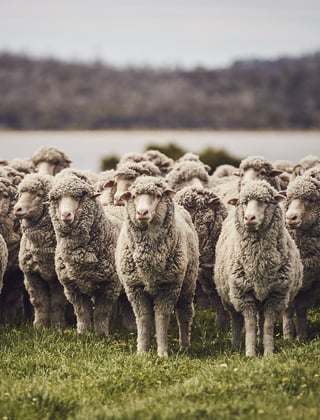EU labelling to display environmental credentials

Within a couple of years, products for sale in the European Union (EU) could be required to include a label that provides consumers with the EU’s assessment of a product’s environmental credentials – this is both a risk and an opportunity for wool.
Within a couple of years, products for sale in the European Union (EU) could be required to include a label that provides consumers with the EU’s assessment of a product’s environmental credentials – this is both a risk and an opportunity for wool.
AWI’s continued funding of scientific research into wool’s environmental benefits not only helps the wool industry’s ongoing marketing of Australian wool but also aims to help ensure the EU develops an accurate and positive rating for products containing wool.
FAST FACTS
- AWI funds scientific research into wool’s environmental footprint, to help the wool industry market Australian wool to the fashion and textile trades – and consumers – as the ‘planet-friendly’ fibre of choice.
- Through the IWTO, AWI is engaging with the EU’s Product Environmental Footprinting (PEF) project, which is expected to soon become the most influential market-facing reporting system for environmental credentials.
- AWI advocates for robust science to underpin the PEF’s rating methods, thereby maximising wool’s reputation and minimising the risk that wool could be disadvantaged.
- In May, a full cradle-to-grave Life Cycle Assessment (LCA) for a Merino wool jumper was published; funded by AWI, it is the first full LCA for a textile fibre that has ever been published in a peer-reviewed journal. It will help the wool industry’s engagement with the PEF project.
Wool is natural, renewable and biodegradable – and therefore well placed to take advantage of the increasing consumer demand for more earth-friendly products.
But the wool industry faces an issue. Environmental ratings agencies don’t yet account for factors such as natural, renewable and biodegradability in their ratings tools, so have historically rated wool poorly against synthetic fibres, which has put wool at a disadvantage, particularly as these ratings have been used by brands to help choose what fibre to use in their products.
This issue has recently become more significant, with the European Union (EU) now putting policies in place to have environmental labelling on consumer products, including apparel products, as soon as 2022, in an effort to guide consumers towards choosing the most sustainable products (see below).
“AWI continues to be dedicated to generating scientific evidence of wool’s true environmental credentials. It is only by undertaking and publishing technically sound scientific studies that wool’s true environmental credentials will be established, leading to improved environmental ratings for wool,” said AWI's Program Manager for Fibre Advocacy and Eco Credentials, Angus Ireland.
“This is a prime example of where AWI’s R&D and marketing are aligned and working hand in glove for a better future, not just for woolgrowers and regional Australia, but for the planet.”
LIFE CYCLE ASSESSMENT
There are many ways to assess environmental sustainability, but one popular and effective method is Life Cycle Assessment (LCA). LCA is a tool that attempts to tell in technical terms the environmental story of products across their entire supply chain – from raw material production; through processing, manufacturing and distribution; to a product’s use, repair and recycling; and finally to a product’s end-of-life and disposal. All these phases of a product’s supply chain affect the environment is some way.
Wool has a great environmental story to tell, so why have ratings agencies rated wool poorly? Until recently, assessments have looked only at the production part of the supply chain (where natural fibres such as wool and cotton are scored poorly), not at the whole supply chain. This means that, for example, the fact that wool is 100% biodegradable (in contrast to synthetics) has not been taken into account by the agencies.
During the past ten years, AWI has been funding research to improve the body of LCA studies and provide a more accurate analysis of wool’s environmental benefits.
A ground-breaking new study funded by AWI has recently been published. It is the first cradle-to-grave LCA of a textile fibre to be published in a peer-reviewed journal, in this case The International Journal of Life Cycle Assessment.
The study demonstrates that consideration of the length of time a garment stays in active use is critical in LCA.
“The study brings together the last decade of AWI’s eco-credentials research across all life stages, from the farm to end-of-life, and contributes to our strategy of positioning wool as a forward-looking industry, carefully stewarding the environment,” Angus said.
“By undertaking the study, we are now in a ‘knowledge-powerful’ position regarding wool’s supply chain and understanding its impacts. The work is especially timely as it will assist the wool industry’s engagement with the European Union’s Product Environmental Footprinting project.”
EU PRODUCT ENVIRONMENTAL FOOTPRINT PROJECT
The EU has become the driving force of environmental footprinting for all product types, not just textiles, through its Product Environmental Footprinting (PEF) project. The project is expected to supersede previous environmental rating systems such as the Sustainable Apparel Coalition system.
It is anticipated that the PEF project will become the most influential market-facing reporting system for environmental credentials, with point of sale collateral (such as labels) communicating the EU’s assessment of products’ environmental credentials. It is predicted to be market ready in the EU by late 2022 and may then be mandated in, for instance, France soon after.
“The wool industry has a seat at the table at key technical forums in the EU. We are working to ensure the environmental footprint of garments is correctly assessed at all stages of a product’s life,” Angus said.
The EU PEF has some advantages over previous rating systems, such as it being a government- initiated and -led system so its principles are better and more scientifically robust. It is also more comprehensive and includes 16 impact categories, from toxicity to climate change, although there are still some notable omissions such as microplastics – see box below. Importantly, the PEF does include the ‘use phase’ and the ‘end of life’ of the garment which helps somewhat in leveling the playing field for wool.
While there are advantages to the PEF system, the requirement for point of sale labelling is still a risk for wool if the EU does not give wool a fair rating. The EU will provide a product with a single rating, rather than providing separate ratings for all 16 impact categories.
At this stage, it is not clear how well wool will be scored by the EU. However, initial modelling suggests the EU’s rating of environmental impacts from wool may be higher than some competitor fibres because of, for instance, a high weighting for on-farm greenhouse gas production.
AWI is working hard to improve the assessment for wool in the following areas:
- Addressing errors in LCA methods. For example, an AWI-funded study has proposed an improved method for allocating environmental impacts across co-products, given that wool is produced alongside meat, which gives a more positive assessment of wool’s environmental credentials.
- Investigating impact categories in which little work has currently been undertaken (eg land use) and ‘hot spots’ that might not be as positive for wool (eg greenhouse gas emissions, particularly at the farm stage).
- Ensuring methane is accounted for correctly, given its relatively short life in the atmosphere before being broken down into other compounds.
- Advocating for regionally relevant methods for issues such as nutrient loss at the farm stage. The circumstances that the EU methodology uses are Europe-centric which are quite different to many other parts of the world, especially Australia.
- Rewarding products that are washed less frequently. Providing evidence regarding the less frequent washing of wool garments will strengthen the case for wool compared to other fibres.
- Addressing the weaknesses of other fibre types, for example by urging the inclusion of indicators such as microplastics and methods to address short-lived fashion types.
What about microplastics?
The release of microplastics into the environment is not currently assessed by LCA because there is no established method to assess its extent or impact. To address this knowledge gap, AWI recently partnered with environmental services company Quantis and other stakeholders in the Plastic Leak Project.
This project has now released a methodology for businesses to map and measure plastic and microplastic leakage across their value chain. However, a further phase of work is required to account for the impact of these microplastics on the environment.
Because wool biodegrades in marine environments, the inclusion of microplastics in LCA should benefit wool’s standing in comparison to synthetic fibres. See www.quantis-intl.com/plastics for more details.

This article appeared in the September 2020 edition of AWI’s Beyond the Bale magazine. Reproduction of the article is encouraged, however prior permission must be obtained from the Editor.














